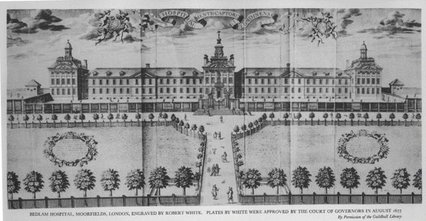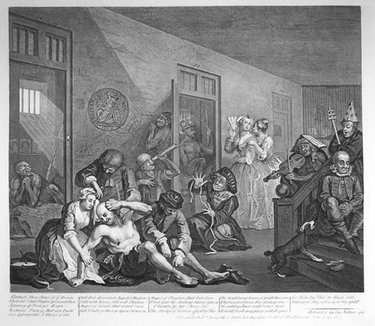Institutions
Before the rise of the asylum people who were considered “mad” were either cared for personally by their family and friends, or driven away to live on the streets. Then, in England, an act was passed in 1575 allowing for the creation of “houses of correction” for “the punishment of vagabonds and the relief of the poor” 27. These places could be owned by anyone who had a facility and an interest and these owners were paid by the government. They housed criminals, the poor, and the mentally ill with no distinction made between the two. These populations were used as unpaid labor, but many times the mentally ill could not keep up with the grueling workload. Due to their symptoms they were disruptive to their fellow inmates as well as those who ran the workhouse 28. To combat this problem the first state run asylum was to house and treat this problem population.
Those who were deemed mad were confined for many reasons. They were disruptive to their families and the surrounding community. If they suffered from manic symptoms they were extremely erratic and could be prone to fits. It was not understood how to care for these people who did not fit neatly into society. The most common reason for confinement however, was simply to avoid the scandal of having a family member who was mentally ill. “That which is called a base action is placed in the rank of those which public order does not permit us to tolerate- it seems that the honor of a family requires the disappearance from society of the individual who by vile and abject habits shames his relatives” 29. Mentally ill people were placed safely behind the doors of an asylum in order for their relatives to preserve their family name. Madness was not only terrifying to people in the 18th century, it was embarrassing.
Conditions of metal hospitals varied from location to location, but they were generally unsavory. Patients were often kept in cages like animals, or cells like prisoners 30. Those who were calm were sometimes allowed to walk around outside if escorted by a doctor or nurse, but those who were deemed dangerous or untreatable were often left alone in cells, sometimes for years. They were kept in a similar manner to criminals “generally chained to the walls and to the beds” 30. One man, considered particularly dangerous “was attached by a long chain that ran over the wall and thus permitted the attendant to lead him about from outside; around his neck had been placed an iron ring, which was attached by a short chain to another ring; this latter slide the length of a vertical iron bar fastened to the floor and ceiling of the cell” 31. It is reported that this man lived chained in this manner for twelve years. Patients were often not allowed the decency of remaining clothed. If they were given any clothing it was one small item that was never washed or replaced, but since many of these sick people would tear off their clothing during fits, many were simply housed naked. The ability of mad men and women to sleep seemingly comfortably naked in their cells during the intense cold of winter contributed to the idea of madmen being inhuman. These poor conditions were never questioned by the upper class both because they would be time consuming and expensive to change and because they were sadly similar to those endured by the “sane” poor 32.
Insanity was often viewed as man returning to his animal instincts. It was along this path of thought that the “cures” that are often viewed as brutal torture today were originally developed. “The free animality of madness was tamed only by such discipline whose meaning was not to raise the beastial to the human, but to restore man to what was purely animal within them” 33. Once, you were categorized as mad, you were not longer human, but an animal to be tamed. Patients were whipped and beaten into submission. They were chained up or kept in cages and not allowed to walk around. They were forced to endure bloodletting, shaking, and near drowning all in the name of finding a cure.

The most famous English mental institution was Bethlem Royal Hospital, more popularly known as Bedlam. It has origins tied back to the early 1200’s but wasn’t a hospital until 1330. It burned down and was rebuilt in 1676, in its third location in London. Bethlem was in a sense a portal to Bedlam, a world of madness. “It is in this sense of imposing crazy caricatures on the historically real Bethlem that Bedlam serves as both a mask and a mirror of madness.”22 Due to the new architectural structure and location amongst Moorfields, one of the last vacant plots of land in London, large numbers of tourists were allowed to visit the hospital. The selling points to the sightseers were not so much the appearance of the building but what was inside: criminals and clinically insane individuals. From starting as a hospital dedicated to help people to allowing thousands of tours that showcased individuals with disability and mental health issues, Bedlam (the literal translation being “a scene of uproar and confusion”) turned into a freakshow.
